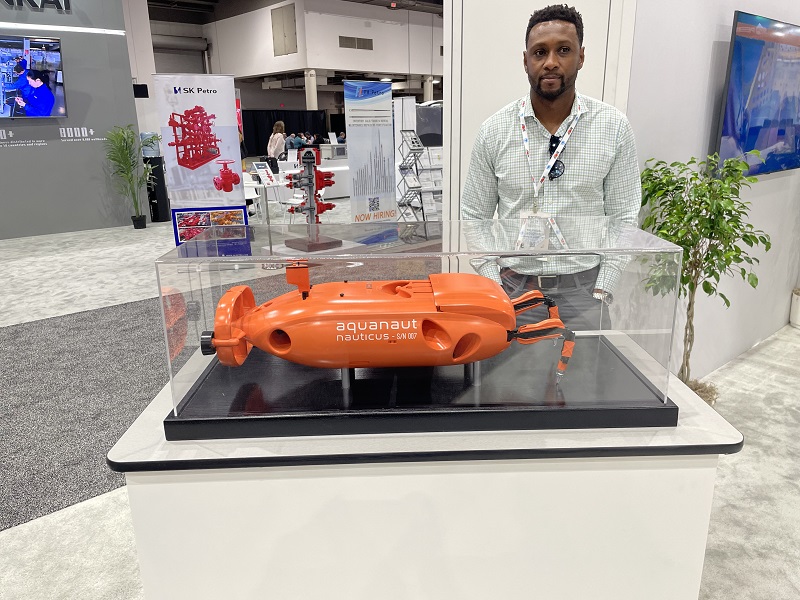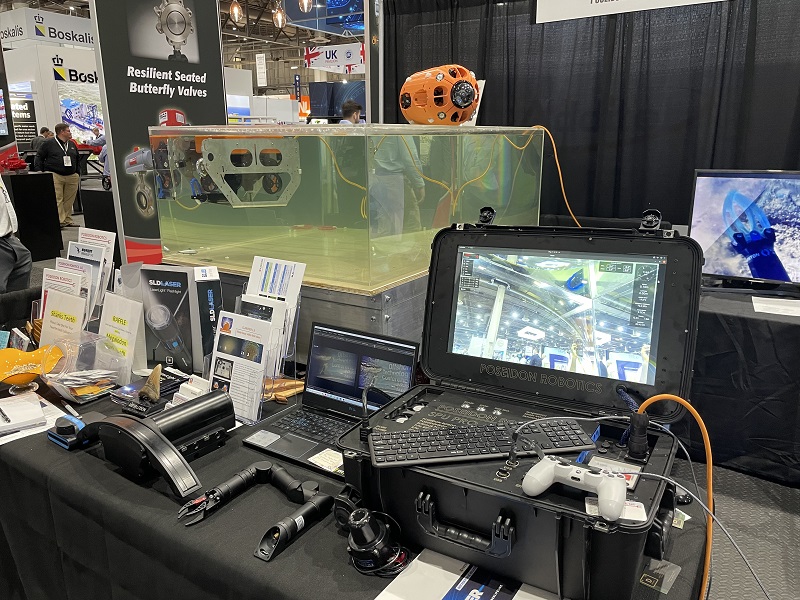
The calling card for many displays at the 2023 Offshore Technology Conference: subsea robotics. (Source: Hart Energy)
The Offshore Technology Conference is known as much for its high-minded exchange of ideas, marquee speakers and vigorous debates as it is a chance to show off.
Technology, naturally, is the conference centerpiece and 2023 brought manufacturers and operators out to showcase the offshore energy sector’s best work, innovations and coolest whizbang toys.
The name of the game this year was robotics, and a plethora of companies unveiled some of their latest and greatest offerings to the subsea sector.
Delmar Systems
Delmar Systems strutted out two products focused on bringing speed to the offshore mooring industry: the RAR Plus and the Stevadjuster.
Typically, seven days pass between the release of a semisubmersible rig and it's ability to get underway. The RAR Plus is Delmar’s new anchor release system that enables a speedier rig disconnection from anchors — just less than two hours, easier rig mobility in case of storms and lower costs.
“In the North Sea area, there’s harsh waters and tough weather that make it hard to move,” Delmar Chief Commercial Officer Leopoldo Bello told Hart Energy. “Because of this, it can take a while to gather your anchor since you can’t leave when the weather is bad,” Bellow said. “With this, you can remotely release anchor, leave, and the anchor can be picked up at a later date.”
The Stevadjuster, which was created by Vryhof —a Delmar subsidiary —provides lifetime mooring adjustments for floating devices. The Stevadjuster is positioned in the mooring line and stays in place to provide flexibility for the life of the floating asset. This makes onboard winches redundant. The Stevadjuster is built to order and does not require the chain to be cut, saving on capital expenditure and reducing hot work. The Stevadjuster has been used on floating wind and floating storage regasification units. It’s currently in use offshore the Congo, Ivory Coast and Norway.

Nauticus Robotics
Nauticus Robotics is working to change how subsea work is done.
“ROVs are limited in what they can do. Then you have AUVs that are also limited at what they can do,” Jide Akinyode, vice president of engineering at Nauticus, told Hart Energy. “Anybody who's trying to do work has to carry both of these two things together or use them one time or another. Nauticus is here to kind of bridge those two vehicle paradigms together and combine them.”
The Aquanaut is Nauticus’ answer to bridge that gap and combine an ROV and AUV.
While it won’t be able to replace heavy work class vehicles, the all-electric Aquanaut is capable of roughly 80% of the tasks ROVs and AUVs can perform, Akinyode said. Rated to 3,000 m water depth, the Aquanaut can also be equipped with Nauticus’ Olympic Arm, allowing it to manipulate objects and do further subsea operations. Due to its tether-less nature, the Aquanaut has no need for a topside platform.
The Aquanaut isn’t the only offering Nauticus brought to OTC. The company also showed off a model of their Hydronaut. Working in tandem with the Aquanaut, the Hydronaut is a “taxicab for the Aqua,” Akinyode said. It carries the Aquanaut where it’s needed and deploys it. The two use acoustic communication to relay information to each other.
While full autonomy hasn’t been reached yet for both of these products, Akinyode says that is their next step. The increase in autonomy will keep divers safe by getting them out of the water and save capex by keeping crews smaller.
Oceanbotics
Oceanbotics, a subsidiary of California-based RJE International, focuses on ROVs. Established in 2017, Oceanbotics’ two main products are the SRV-8 ROV and the SRV-8X Optimus ROV.
The SRV-8, introduced to the market in 2017, is a battery-powered ROV capable of lasting six hours to eight hours while diving to water depths of 305 m. It is also equipped with two 3000-lumen lights, two ethernet inputs and 100 m of tether.
The 8X, introduced in 2022, is a slightly larger version of the SRV-8 with a shorter, four- to six-hours battery life that can handle 500 m of water depth and is equipped with 250 m of tether.
“We service industries all the way from the military applications to treasure hunters, and everything in between,” Waylon Price, manager for Oceanbotics, told Hart Energy. “But for oil and gas, we do hole inspections, pipeline inspections, anchor inspections. We can do underwater GPSing to know exactly where the pipe is. We have attachments that go on the front of the ROV, like an ultra-thickness gauge, which can tell you the integrity of the pipe all the way down so we can see if there's any issues or problems ahead of time.”
Both the SRV-8 and SRV-8X are equipped with sonar for function for ops in murky water. While not autonomous yet, that is the next hurdle that Oceanbotics looks to climb for their ROVs.
“Currently we don't have any autonomy built into our system, but that's something we're striving to add to future versions of our software,” Price said.

Poseidon Robotics
Poseidon Robotics has partnered with Lolaark Vision and Mission Robotics to bring the industry the Lanai Pro and Maui ROVs.
The Lanai and Maui are what Emanuel Papadakis, president and CEO of Lolaark Vision, called “the Kia of ROVs,” in that they do all the things a standard ROV does, but at a much cheaper price. The Lanai Pro is rated for 400 m water depth, can reach a speed of 3 knots and has a payload capacity of 2.5 kg. The Maui is similarly built to the Lanai Pro, with the main difference being a payload capacity of 10 kg.
Both ROVs are equipped with low-latency cameras, courtesy of Mission Robotics, that enable all video captured with the ROV to be transmitted back to the ship almost instantaneously. They are also equipped with Lolaark Vision’s Clarifier 1.0. The clarifier removes the effects of water turbidity on the cameras and enhances shapes for a better image, even in harsh and hazy conditions.

Saab Seaeye
Saab Seaeye focuses on electric capabilities with underwater robotics.
“We’re all electric. We don’t build any hydraulics,” Chris Roper, manager at Saab Seaeye, told Hart Energy. “All the propulsion is electric, so we don’t have a concern about blowing a hydraulic line or having a leak.”
During OTC, Saab Seaeye showcased its Falcon and Cougar-XT ROVs. The Falcon comes rated to a depth of 300 m and is equipped with five thrusters to provide stability in turbulent waters. The Falcon’s open frame build allows easy attachment for sensors, sonars, tooling and other accessories. The Cougar-XT is larger than the Falcon and can work in water depths of 2,000 m. The Cougar is designed to help with heavy-duty tooling through a system of quick-change tool skids. The Cougar-XT is flexible and can perform survey work, inspection, repair and maintenance work, drill support, light construction projects and salvage support operations.

VideoRay
The Mission Specialist Defender is VideoRay’s new, state-of-the-art ROV. Rated to 1,000 m water depth, the Defender is used for visual inspections, cleaning, offshore tasks and light tooling. It is also equipped with ultrasonic thickness and metal thickness gauges. Customers have the ability to add their own sensors and toolings to the ROV.
And the ROV is travel-ready.
“All of our systems are one-man portable,” said VideoRay manager Jeff Orlowski. “You can easily take them on a commercial flight or put them in a helicopter and take them offshore. The systems are also modular, so you can take our base platform and build your sensors around it.”
The ROV is tether-operated but still highly flexible and maneuverable, making it ideal for waypoint navigation. The software interface of the Defender is made by Greensea, but others are able to program software for the ROV due to its customizable nature.
Recommended Reading
D-J’s Elevation Midstream, ARB Midstream Subsidiary to Merge
2024-07-08 - Elevation Midstream and Platte River Holdings, a subsidiary of ARB Midstream, are merging to create a D-J Basin midstream company of scale.
Delek Logistics Acquires EIV’s H2O Midstream for $230MM
2024-08-06 - Delek Logistics acquired H2O Midstream, a portfolio company of EIV Capital and the largest pure-play water midstream company in the Permian Basin, with more than 250 miles of pipe.
Martin Resource Sidesteps Firms’ Criticism, Offer for Midstream MLP
2024-07-11 - Martin Resource Management, which in May proposed buying spinoff Martin Midstream Partners, responded to two capital firms’ counteroffer made public July 11 by saying it’s not interested.
Williams Denies Seeking Buyout of Targa
2024-09-04 - Williams denied reports from anonymous sources that Targa had rebuffed “informal” interest from Williams.
EQT Closes $5.45B Acquisition of Equitrans Midstream
2024-07-22 - In addition to integrating Equistrans’ midstream assets, EQT will focus on reducing the infrastructure company’s debt of between $7.6 billion and $8 billion. Including equity and debt, the deal is valued at roughly $13 billion.
Comments
Add new comment
This conversation is moderated according to Hart Energy community rules. Please read the rules before joining the discussion. If you’re experiencing any technical problems, please contact our customer care team.






